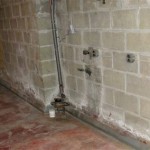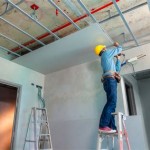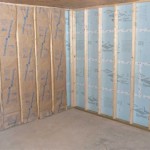Best Flooring Options for a Cement Basement Bathroom
Choosing the right flooring for a basement bathroom, particularly one with a cement subfloor, presents a unique set of challenges. Basements are inherently prone to moisture, temperature fluctuations, and potential flooding, all of which can negatively impact flooring materials. Therefore, selecting a durable, water-resistant, and comfortable flooring option is crucial for a successful and long-lasting bathroom renovation. This article explores several suitable flooring solutions for cement basement bathrooms, outlining their advantages, disadvantages, and key considerations for installation and maintenance.
One of the primary concerns in any basement bathroom is moisture. Cement subfloors, while structurally sound, can wick moisture from the ground, leading to mold growth, mildew, and eventual flooring damage. Therefore, the chosen flooring material must be able to withstand prolonged exposure to moisture or be installed with a proper moisture barrier. Furthermore, the flooring should be comfortable underfoot, as cement can feel cold and hard, especially during colder months. Finally, ease of installation and maintenance are also significant factors to consider, particularly for DIY projects.
Understanding the Challenges of Cement Basement Bathrooms
Before delving into specific flooring options, it is essential to understand the challenges inherent in cement basement bathrooms. Cement, while a strong and stable base, is porous and can absorb moisture from the ground and surrounding environment. This moisture can then migrate through the cement and into the flooring material, causing warping, buckling, and the growth of mold and mildew. The lack of natural light in many basements can also exacerbate these issues, as moisture evaporates more slowly. Furthermore, the temperature in basements tends to fluctuate more than in above-ground spaces, which can put stress on flooring materials and cause them to expand and contract.
Proper preparation of the cement subfloor is paramount before installing any type of flooring. This includes thoroughly cleaning the surface to remove any dirt, debris, or existing adhesives. It may also be necessary to repair any cracks or uneven spots in the cement using a concrete patching compound. A moisture test is crucial to determine the level of moisture present in the cement. This can be done using a calcium chloride test or a relative humidity probe. If the moisture levels are too high, a moisture barrier must be installed before laying the flooring. Failure to address these issues can lead to premature flooring failure and costly repairs down the line.
In addition to moisture concerns, the cold, hard nature of cement can make standing on it for extended periods uncomfortable. Therefore, choosing a flooring material with some degree of cushioning or installing an underlayment can significantly improve comfort. Consider also the potential for water leaks from plumbing fixtures and appliances. Leaks can quickly saturate flooring and lead to extensive damage if not addressed promptly. Therefore, choosing a water-resistant or waterproof flooring option is highly recommended for basement bathrooms.
Exploring Suitable Flooring Options
Several flooring options are well-suited for the unique challenges of a cement basement bathroom. These include luxury vinyl tile (LVT), engineered hardwood, ceramic or porcelain tile, and epoxy flooring. Each option offers a different combination of durability, water resistance, comfort, and aesthetic appeal.
Luxury Vinyl Tile (LVT): LVT is a popular choice for basement bathrooms due to its excellent water resistance, durability, and ease of installation. It is available in a wide range of styles, including those that mimic the look of wood, stone, and ceramic tile. LVT is also relatively soft underfoot compared to tile, making it more comfortable to stand on. The interlocking nature of many LVT products also simplifies installation, making it a suitable option for DIY projects. High-quality LVT options are waterproof, resisting damage from spills and minor flooding. A significant advantage of LVT is its layered construction, which typically includes a wear layer, a decorative layer, and a backing layer. The wear layer protects the flooring from scratches and stains, while the backing layer provides stability and cushioning. Some LVT products also include a built-in underlayment, further enhancing comfort and reducing noise transmission.
Engineered Hardwood: While solid hardwood is not recommended for basements due to its susceptibility to moisture damage, engineered hardwood can be a viable option with proper precautions. Engineered hardwood consists of a thin layer of hardwood veneer bonded to multiple layers of plywood or high-density fiberboard (HDF). This construction makes it more stable and less prone to warping or expanding and contracting in response to moisture and temperature changes. However, even engineered hardwood is not entirely waterproof and should be installed with a moisture barrier and a vapor retarder. In addition, be prepared to regularly maintain this flooring. This is not an ideal choice if flooding is a concern.
Ceramic or Porcelain Tile: Tile is a classic choice for bathrooms due to its durability, water resistance, and aesthetic versatility. Ceramic and porcelain tiles are both excellent options for basement bathrooms, although porcelain tile is generally more durable and less porous than ceramic tile. Tile is impervious to water damage and is easy to clean and maintain. It is also available in a wide range of colors, sizes, and styles, allowing for a variety of design options. However, tile can be cold and hard underfoot, so installing a radiant heating system or using rugs can improve comfort. Grout lines between tiles can also be susceptible to mildew growth, so it is important to use a mildew-resistant grout sealer and clean the grout regularly.
Epoxy Flooring: Epoxy flooring is a durable and waterproof option that is becoming increasingly popular for basement bathrooms. Epoxy is a thermosetting resin that is applied as a liquid and then hardens to form a seamless, non-porous surface. It is resistant to water, chemicals, and stains, making it an excellent choice for high-moisture environments. Epoxy flooring can also be customized with a variety of colors, textures, and patterns. However, epoxy flooring requires professional installation and can be more expensive than other flooring options. Although durable, epoxy can be subject to scratching if not maintained.
Key Considerations for Installation and Maintenance
Proper installation and maintenance are crucial for ensuring the longevity and performance of any flooring material in a basement bathroom. As mentioned earlier, thorough preparation of the cement subfloor is essential. This includes cleaning, repairing, and testing for moisture levels. If moisture levels are high, a moisture barrier must be installed before laying the flooring.
When installing LVT or engineered hardwood, it is important to follow the manufacturer's instructions carefully. This typically involves allowing the flooring to acclimate to the room temperature for several days before installation. It is also important to use the correct adhesive and tools to ensure a proper bond. For tile installations, proper grout selection and sealing are critical for preventing mildew growth.
Regular cleaning and maintenance can help to extend the life of your basement bathroom flooring. For LVT and engineered hardwood, regular sweeping and mopping with a mild detergent are usually sufficient. Avoid using abrasive cleaners or harsh chemicals, as these can damage the flooring surface. For tile floors, clean the grout lines regularly with a grout brush and a mildew-resistant cleaner. For epoxy flooring, wipe up spills promptly and use a mild detergent to clean the surface. Avoid using harsh chemicals or abrasive cleaners, as these can damage the epoxy coating. Regularly inspect the flooring for any signs of damage or wear and make repairs as needed. Addressing minor issues promptly can prevent them from escalating into more serious problems.
In addition implementing a humidity control system is important to keep proper maintenance of basement bathroom flooring. Humidity control will prevent the growth of mold or mildew from occurring.

What Are The Best Flooring For Basement In Homes

6 Inspiring Ideas For Basement Flooring In Portland

Best Basement Flooring Options Cork Floating Floors Icork Floor

What S The Best Flooring For A Cement Basement Floor

Concrete Floor For Curbless Shower Basement Bath Youtube

What Is The Best Flooring For Concrete Slabs 50floor

5 Best Carpeting Ideas For Basements

2024 Buyer S Guide Best Basement Flooring Over Concrete

Diy Concrete Floor Cheap Home Diys Design Mom

Bathroom Flooring Options Hgtv
Related Posts







